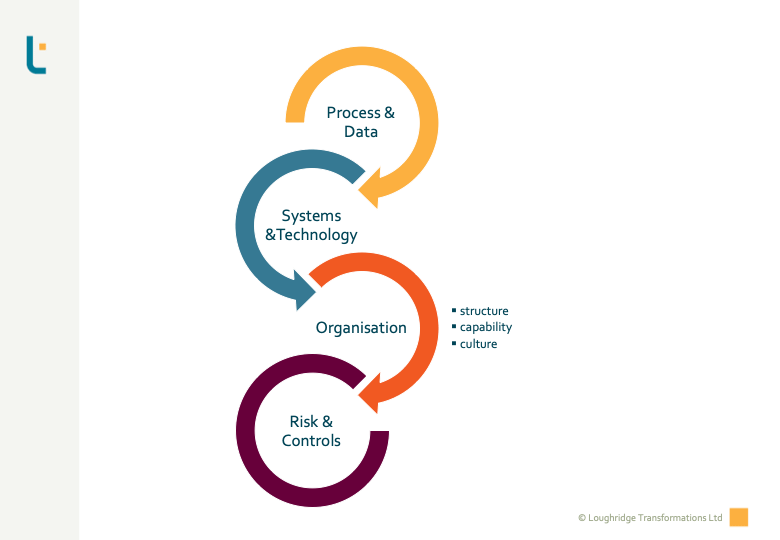How to Design an Organisation to Respond to the Needs of the Customer

AUTHOR: JENNIFER LOUGHRIDGE
PRINCIPAL CONSULTANT
Jennifer is a Senior Executive Finance professional with 17+ years of global experience. She specialises in Finance Transformation and Continuous Improvement, with particular expertise in Strategy, Performance Management, Business Partnering, Commercial Decision-Making, Corporate Governance and Valuation.
jennifer.loughridge@loughridgetransformations.com
Finance Organisational Model – Why Do You Need a New Design?
There are several triggers to step back and shape or re-shape your Function through new organisational models. Perhaps, the Function (or the overall organisation) has grown over time. Or, maybe a merger or acquisition has resulted in several functions coming together. Alternatively, the organisation may have experienced fast-paced growth, and the Functions can no longer meet organisational requirements. Perhaps, they need to develop their digital capacity and capabilities. However, on the other hand, the cost and outputs may be unacceptable or benchmarked below expectation.
As recent research at Gartner indicates, in 2022, there are further triggers:
CFOs and Finance Executives are continuously assessing and revamping their finance strategy in response to the changing needs of internal and external customers. Organisational structure re-design is one of the ways Finance can effectively adapt to these evolving needs.
Finance function leaders have long focused on standardising workflows and roles to increase efficiency, but standardised models proved brittle during the volatility of COVID-19. The impact of rising organisational complexity on finance’s closeness to decision-makers cannot be overlooked. Today, decisions are made more quickly and at lower levels within the organisation, which increasingly limits finance’s ability to remain updated on decision-makers’ business priorities and challenges throughout the organisation.
Gartner 2022
Finance Organisational Model: Getting It Right
Whatever drives you to embark on this change, proactively designing and deploying a new organisational model, including the relevant structure, competencies and behaviours, means you maximise the use of team members’ skills. You also avoid inconsistent or sub-optimal delivery from human- and machine-based roles. Introducing (or deepening) a shared-service model or outsourcing services to a third-party provider makes this more critical. Ultimately, addressing all of these improves the relationships with business partners and the team’s morale.
So, how do you get it right? How do you ensure your model addresses the internal and external customers’ needs? For all the transactional and business-facing teams?
Finance Organisational Model – Setting the Scene
Before going any further, let’s be clear about where organisation – specifically structure, capability and culture – fits into overall Finance Transformation.

Here is the Loughridge Transformations Four Elements of Transformation Model, which starts with Process and Data. Next comes Systems & Technology, Organisation and Risk & Controls.
We reference the other elements because, with Finance Transformation, there is significant inter-dependency between the elements.
In addition to understanding the Four Elements of Transformation and how they relate. It is also helpful to have a basic understanding of the types of organisational structures:
There will often be limited freedom when designing an organisation for a function. The functional organisation, of course, will have to fit within the overall organisation logically and in a workable manner.
Of course, you have much more freedom when looking at an entire organisation. However, as the video alludes to, the strategy of the organisation and the organisational culture will impact your choice. Therefore, how much genuine choice you will have in the design here depends on how far-reaching the transformation is.
Loughridge Transformations‘ Step-By-Step Model
So, we now reach the point where we share the Loughridge Transformations’ step-by-step model for achieving Effective, Efficient, Well-Controlled and Sustainable Performance.


You might be looking at the model now and thinking, “Wow, fourteen steps! That is a lot. That is probably too much for my organisation!”
At Loughridge Transformations, nearly all our models are “scalable and modular”. Everything we do can work standalone or be fitted together. It also means that the principles can be applied to small, large and global, multi-national scales of organisations.
The fourteen steps above can work in the most sizeable organisations with thousands of Finance staff. However, it also works at the other end of the spectrum. We have successfully used this model with organisations at both ends of that spectrum.
There is far more detail behind each step than we could do justice to in a blog post. So today’s post will serve only as an introduction.
Finance Organisational Model – Step 1: Determine Processes
Our Four Elements of Transformation start with Processes. If you are unfamiliar with what is involved in this step, check out our recent post on Process Models:
Finance Organisational Model – Step 2: Determine Process Steps
For each process in scope, you will need to determine the steps at a sufficient level of detail, at least, to define roles later. Again, our Process Model post touches on Process Hierarchy and levels of design.
Finance Organisational Model – Step 3: Determine Automation
This step is mainly about understanding which activities will be executed by a machine and a human. Here you want to ensure you have fully exploited the functionality of the existing or new technology. Again, our post on the Essential Ladder of Implementation can help you here.
Finance Organisational Model – Step 4: Assess Process Risk and Design the Controls
Process risk is a topic in its own right, so we will not delve into it here. However, it is an important topic, so we plan to feature this in an upcoming blog. You might also be interested in our Circle of Control on our Governance page.
Finance Organisational Model – Step 5: Design Process Roles
All human- or machine-operated roles should be included at this stage. That way, the link between process steps and organisational execution is clarified. That’s also why the design should incorporate control operation. It also makes it much easier to combine work instructions and control operation procedure documentation later in the design. That, in turn, simplifies things for the process or control operator. The same goes for user access profiles. Completing an end-to-end overview of the technology makes it transparent what is machine-operated and what a person does. It also becomes much easier to identify the correct user-access profiles for the process operators. Naturally, this also sheds light on the Segregation of Duties conflicts when drawing up the design.
Non-Transactional and Non-Routine Activities
It may be helpful to reflect on what this means when looking at organisational activities that are non-transactional and routine and non-routine.
These activities, for functions, usually comprise the bulk of Business Partnering and Centres of Excellence activities. But, on the other hand, anything transactional and routine properly belongs in a shared-service set-up, whether off-shored or outsourced.
Process Design is often far less detailed in this space. As a result, design teams usually steer away from fully including this in the scope. At Loughridge Transformations, we understand why that happens. However, we strongly caution against it.
The result will be an organisation where the right-hand doesn’t know what the left hand is doing. In practical terms, that means messy hand-offs, the potential for duplication and error, poor grip on controls, not to mention team behaviours that don’t support the organisation’s sustainability. As a result, it will scarcely take you to top-quartile performance and not world-class performance levels.
It is all very well, but it is often left out of scope because it is difficult. Maybe it is more difficult, but I would argue that it is merely different and requires an alternative approach.
Is your organisation considering transforming the non-transactional activities? Then, don’t hesitate to arrange a call with us to learn how we execute this part of the design.
Finance Organisational Model – Step 6: Determine Location
There are some considerations in terms of location when designing an organisation model. One primary driver is the synergies available in terms of cost, efficiency and resource availability when looking at potential consolidation or centralisation. That can drive the off-shoring approach to shared-service locations or Centres of Excellence – for the finance back-office, IT and Customer Support, to name a few examples.
Language ability is often one significant consideration, and the potential locations need a good talent pool. In addition, the proximity of some activities (usually in affiliate roles) can be an essential productivity enabler. Sometimes, the positioning of roles is driven by strategic locations based on the market or business prioritisation, where the volume of business or the market positioning determines the location of a designated hub.
Larger organisations can benefit from a “follow-the-sun” schedule, usually configured as three eight-hour shifts in different parts of the world. So think about starting in Asia, passing the baton to Europe, passing it to the Americas, and returning it to Asia.
Sometimes there are trade-offs when working across time zones – you will still need enough overlap in working hours between business-proximate and shared-service team members to make it all work. Perhaps some of that can be addressed by shift patterns, which may only be needed during critical month-end schedules. Alternatively, it may drive which centre works with which location, or if you only have one shared-service location, where it is located vis-à-vis the business locations.
Finance Organisational Model – Step 7: Map Roles to Jobs
So, to be precise – we don’t map roles to an individual. Instead, we map roles to jobs and assign a job to a named individual. But, of course, this step must work hand-in-hand with the previous step, i.e., location determination.
When doing this role to jobs mapping, we usually start with the standard mapping. As a result, we will have a set of standard jobs. However, we usually will end up having to localise standard jobs. This localisation means we will add or remove particular roles for the job, essentially creating a variance of that job.
Why do we do this? It is usually for efficiency or mitigating any compliance issue. For example, in smaller business operations, a standard job may not justify one whole FTE. In this case, we can combine more than one job or assign additional roles to a job – as long as it doesn’t create any Segregation of Duties conflict.
The Perfect Design?
We must realise it is still a desktop exercise for organisational design. Therefore, no matter how good you are, there will need to be iterations to get it right. But moreover, in our experience, this step is best done when the Design Authority has a good understanding of the organisational drivers and the actual content of the roles and standard jobs.
Some will try to use the organisation’s metrics in terms of turnover, capital employed and so on. But, frankly, it is no substitute for having a proper grasp of the business and the Function.
We prefer to apply skill, expertise, and good collaboration with the impacted organisations when moving from design to deployment. Of course, you need to understand the scale of operations. Still, understanding the complexity or lack of it, together with a thorough discussion around fiscal and legal restrictions, is far more valuable.
Finance Organisational Model – Step 8: Design Reporting Structures
As mentioned in the video above, this can be rather organisation-specific, so we will not touch on that here.
Finance Organisational Model – Step 9: Define Competence and Behaviour Requirements for Jobs
In brief, if you are transforming an organisation, jobs will likely change materially, some jobs will cease to exist, and new ones will come in. On top of that, the location could also have changed. So ultimately, you could see many changes in people and jobs.
So, it is a given that there will also be changes in the skills and behaviours needed. Consequently, if you are unclear on the new skills and behaviours, how will you know if the individuals appointed to the positions are ready to succeed?
It is 100% the key to your change’s efficiency, effectiveness, and sustainability.
Finance Organisational Model – Step 10: Evaluate Job Level
This step is about evaluating the job level, that is, how junior or senior each job will be in each location.
Finance Organisational Model – Step 11-14: Capability Assessments and Programmes to Build Capability & Culture
Steps Eleven to Fourteen are all about assessment and recruitment, and eventually full deployment of the capability and culture or, you might say skills and behaviours. We won’t cover those in this post as some elements depend highly on the legislative framework you work within.
Finance Organisational Model: Our Approach
In this post, we have introduced the steps in our organisational design and deployment approach.
We are happy to talk if you want to learn more about our methodologies and working methods. For example, suppose you are considering an organisational re-design or complete transformation, or you have a Finance Organisational Model that you feel has not given you the expected return. In that case, we can perhaps talk about where we could work with you and bring our expertise to bear.
You may be considering introducing (or deepening) a shared-service model or outsourcing services to a third-party provider. Alternatively, you might be looking to review the effectiveness and efficiency of your existing onshore organisation.
Our Experience
If you want to access experience, it may be worth knowing where we gained our shared-service knowledge. We have worked in one of the world’s most sizeable shared-service model set-ups covering six global shared-service centres across all continents.
Consequently, we can offer an in-depth analysis of any existing model you may have and provide recommendations for improvement based on tried-and-tested solutions to ensure your organisation maximises the benefits of the model.
Our Expertise
The team has expertise covering migration methodology, optimisation of activity penetration and integration of on- and off-shore teams, considering, of course, the effectiveness of the structure, skills and behaviours.
Our consultants welcome any discussion on the above and more, so please arrange a call with us!
Find Out More About Working with Loughridge Transformations
Get the Latest from Loughridge Transformations
Subscribe to Our Blog
Alternatively, take a look at our most popular blog posts:
Looking for something else? Here’s what we have been blogging about recently:
Agile Analytics Associates Automation Behaviours Building Trust Business-Partnering CFO Remit Change Management Coaching Collaboration Continuous Improvement Control Design Corporate Governance Data Deployment Design Principles Digital ERP ESG Finance Function Finance Transformation Implementation Migration Off-Shoring Organisation Organisation Design Process Process Design Process Governance Process Performance Productivity Programme Management Office Project Management Readiness Risk & Controls Skills sponsorship Standard Organisational Model Strategy Systems Systems Design Technology Transformation Virtual Working




